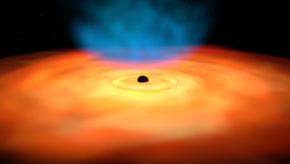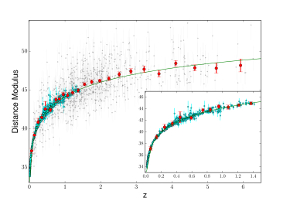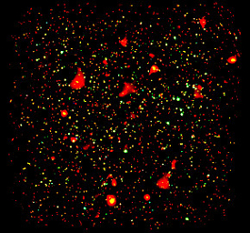A new technique to gauge the distant Universe
3 December 2015
Scientists have developed a technique to use quasars – powerful sources driven by supermassive black holes at the centre of galaxies – to study the Universe's history and composition. To demonstrate the new method, based on a relation between a quasar's luminosity at X-ray and ultraviolet wavelengths, they made extensive use of data from ESA's XMM-Newton X-ray observatory. This approach promises to become an important tool to constrain the properties of our Universe.
 |
| Artist's view of a black hole at the centre of a quasar. Credit: ESA–C. Carreau |
At the core of most massive galaxies in the Universe is a supermassive black hole – a concentration of matter so dense that it attracts anything nearby, including light. Such black holes have masses from millions to billions of times that of the Sun and are generally idle, only accreting the occasional star or gas cloud that ventures too close to the galaxy's centre.
A small fraction of them are, however, extremely active, devouring matter at a very high rate, causing the surrounding material to shine brightly across the electromagnetic spectrum, from radio waves to X-rays and gamma rays. In some cases, emission from matter in the vicinity of the black hole is so intense that the core of the galaxy outshines the stars. These objects appear as point sources in the sky, like stars, and are known as quasars – short for quasi-stellar sources.
Quasars allow scientists to study gravity in the very strong field of the supermassive black holes. In addition, comparing the properties of quasars with those of other galaxies that host either active or passive black holes can reveal interesting aspects about the evolution of galaxies over cosmic history.
But one other aspect piqued the interest of two scientists from the Arcetri Astrophysical Observatory in Firenze, Italy: they realised that quasars can be used as probes of the expansion history of the Universe. The results of their study are presented in a paper, published today in the Astrophysical Journal.
"The history of cosmic expansion holds a wealth of information about the Universe, including its age and the relative abundance of its components, and to pin it down we need to observe astronomical sources at a wide range of distances from us," explains Guido Risaliti, one of the scientists who led the study.
"But determining distances in the Universe is not at all trivial and can be best performed only with a few classes of sources. In this study, we show how it can be done with quasars," he adds.
The main obstacle to measuring distances to astronomical objects lies in our ignorance of their true brightness, which makes it virtually impossible to assess whether a source is intrinsically bright or whether it just appears so because it is very close to us.
For relatively nearby stars in our Galaxy, astronomers can get a very precise handle on distances using parallax – the tiny apparent shift of a star's position in the sky when viewed from different locations in the Earth's orbit. However, the greater the distance the smaller the parallax, which restricts the reach of this method to our local cosmic neighbourhood.
Farther away, astronomers have to rely on 'standard candles' – astronomical objects whose intrinsic luminosity can be calculated from another of their observable properties.
Amongst the most widely used standard candles are supernovae of type Ia – exploding white dwarf stars in a binary system. These explosions release roughly the same amount of energy every time, so their observed luminosity is a good indicator of the actual luminosity and, in turn, of their distance.
In the 1990s, teams of scientists collected many observations of these supernovae to map distances to faraway galaxies and to study how these are affected by the overall cosmic expansion. This led to the surprising discovery that the Universe's expansion is currently accelerating under the repulsive effect of a mysterious dark energy.
In the standard cosmological model, dark energy dominates the present Universe, making up about three quarters of its total energy budget, with the invisible dark matter accounting for about one fifth of the total, and ordinary matter amounting to a mere few percent. But it has not always been so, and delving deep into the history of our cosmos is crucial to figure out the nature and evolution of these 'dark' components.
"Type Ia supernovae are a powerful tool for cosmology, but they cannot be observed at very large distances from us, so they are mostly used to probe the relatively recent Universe," says co-author Elisabeta Lusso.
Few supernovae of type Ia have been observed in earlier cosmic phases, when our almost 14 billion-year-old Universe was younger than 5 billion years.
"This is why we suggest to complement type Ia supernovae with quasars, which can be observed in large quantities out to much greater distances, probing cosmic history up to the epoch when the Universe was only one billion years of age," she adds.
To determine how far quasars are from us, Risaliti and Lusso used an interesting property of these sources: a link between the amount of light they emit at ultraviolet and X-ray wavelengths, which has been known since the late 1970s.
Both types of emission derive from the black hole's activity, although they are caused by different processes. As the accreted material flows towards the black hole through a disc, it is heated by friction and shines brightly at visible and ultraviolet wavelengths. Then, part of the light emitted by the disc interacts with nearby electrons, receiving an extra energy boost and turning into X-rays.
The key point underlying the application of this relation to cosmology is that the link between the luminosities at the two different wavelengths is not linear. This means that the ratio between a quasar's measured X-ray and ultraviolet emission is not fixed, but varies – in a known way – depending on the ultraviolet luminosity itself. So by measuring a quasar's X-ray and ultraviolet emission the scientists can estimate the absolute luminosity at ultraviolet wavelengths; in turn, this can be used to gauge the quasar's distance.
 |
|
Determining distances of supernovae and quasars in the expanding Universe. From Risaliti & Lusso, ApJ, Vol. 815, 2015 |
While the physical mechanism underlying this relation is unclear, Risaliti and Lusso could still use it to treat quasars as standard candles and employ them as distance indicators for cosmological studies.
To do so, they compiled a pilot sample of quasars with both ultraviolet and X-ray measurements, collecting 1138 sources from several data sets that were published in the scientific literature over the past decade. Most of the X-ray data came from surveys performed with ESA's XMM-Newton, including the COSMOS survey.
"First, we verified that the relation between ultraviolet and X-ray luminosity holds for quasars observed at any cosmic epoch: this is an essential condition if we want to treat them as cosmological probes," explains Risaliti.
Then, the scientists determined distances to the quasars in their sample and used these to study how the expansion of the Universe changed in the span of cosmic history covered by these sources. From this, they evaluated the relative abundance of dark matter and dark energy in the Universe, obtaining results that agree with current estimates obtained from supernovae and other observations, albeit with larger errors.
"Quasars are a less precise tool to measure distances than supernovae of type Ia, but they yield complementary information about the distant Universe that is inaccessible to supernova observations," says Lusso.
The power of this new approach is best unleashed through the combination of quasars and supernovae of type Ia, spanning over 13 billion years of cosmic evolution to investigate how the Universe changed across most of its history. In fact, combining data from current surveys of both types of sources yields constraints on the relative abundance of dark matter and dark energy that are tighter and more precise than those obtained from supernovae alone.
The method developed by Risaliti and Lusso appears especially promising in light of future surveys, since a larger quasar sample means smaller errors on the cosmological parameters.
On the X-ray front, the German-led eROSITA instrument on-board the Russian Spektr-RG satellite, planned for launch in 2017, is expected to observe millions of quasars, and ESA's Advanced Telescope for High-ENergy Astrophysics (ATHENA), planned for launch in 2028, could survey up to 10 million quasars. Meanwhile, ESA's Euclid mission, planned for launch in 2020, will observe a few million quasars at visible and near-infrared wavelengths – the portion of the spectrum where the ultraviolet light emitted by distant quasars is redshifted due to cosmic expansion.
"It is very gratifying to see that the data collected by XMM-Newton over many years are being used as the basis for a creative and promising method to investigate the darkest secrets of our Universe," comments Norbert Schartel, ESA XMM-Newton Project Scientist.
More information
"A Hubble diagram for quasars" by Guido Risaliti and Elisabeta Lusso, is published in the Astrophysical Journal.
The study is based on a sample of 1138 quasars that was obtained by compiling many different data sets published previously in scientific papers. The sample contains an estimate of the X-ray and ultraviolet luminosity for each quasar. The X-ray data come mainly from ESA's XMM-Newton X-ray observatory, as well as from NASA's Chandra X-ray Observatory and the German Aerospace Center-led ROSAT satellite. The ultraviolet luminosity was estimated using data from the Sloan Digital Sky Survey, NASA's Galaxy Evolution Explorer (GALEX) and Spitzer Space Telescope, NOAJ's Subaru Telescope, the Canada France Hawaii Telescope (CFHT), the Two Micron All Sky Survey (2MASS) and the UKIRT Infrared Deep Sky Survey (UKIDSS).
The European Space Agency's X-ray Multi-Mirror Mission, XMM-Newton, was launched in December 1999. The largest scientific satellite to have been built in Europe, it is also one of the most sensitive X-ray observatories ever flown. More than 170 wafer-thin, cylindrical mirrors direct incoming radiation into three high-throughput X-ray telescopes. XMM-Newton's orbit takes it almost a third of the way to the Moon, allowing for long, uninterrupted views of celestial objects.
Contacts
Guido Risaliti
INAF – Arcetri Astrophysical Observatory, Firenze, Italy, and
University of Florence, Florence, Italy
Email: risaliti![]() arcetri.astro.it
arcetri.astro.it
Phone: +39-055-2752286
Elisabeta Lusso
INAF – Arcetri Astrophysical Observatory
Firenze, Italy
Email: lusso![]() arcetri.astro.it
arcetri.astro.it
Norbert Schartel
ESA XMM-Newton Project Scientist
Directorate of Science and Robotic Exploration
European Space Agency
Email: Norbert.Schartel![]() esa.int
esa.int
Phone: +34-91-8131-184




